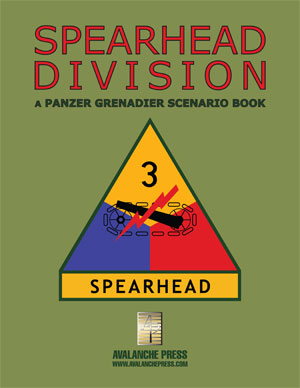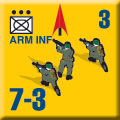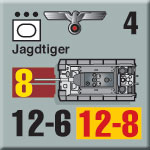Spearhead Division:
Scenario Preview, Part Three
by Mike Bennighof, Ph.D.
November 2023
 Early on in my youthful musings regarding the game system that would become Panzer Grenadier, I wanted it to include special sets of pieces and scenarios devoted to particular famous fighting formations. Yet somehow we managed to avoid publishing such a book for many years. Spearhead Division corrects this oversight; let’s take a look at the third, penultimate (that’s a fancy word for next-to-last) chapter. You can see the rest in Part One, Part Two and Part Four. Early on in my youthful musings regarding the game system that would become Panzer Grenadier, I wanted it to include special sets of pieces and scenarios devoted to particular famous fighting formations. Yet somehow we managed to avoid publishing such a book for many years. Spearhead Division corrects this oversight; let’s take a look at the third, penultimate (that’s a fancy word for next-to-last) chapter. You can see the rest in Part One, Part Two and Part Four.
Chapter Three
Battle of the Rose Pocket
Despite the failure of the initial VII Corps attack into the Hürtgen Forest, American planners continued to focus on that section of the line. Of course, all this planning went on the shelf when the Germans attacked into the Ardennes. Spearhead was involved in reducing the Bulge and then rested, recovered and refit through most of February 1945. Launching its attack on the 26th, Spearhead rolled across the Roer (after the flood) and raced forward, finally achieving a breakthrough.
Cologne on the west bank of the Rhine fell on March 7 as the Allied armies pulled up to the great river along its length. As Spearhead rolled into Cologne just in time to watch German engineers blow up the Hohenzollern Bridge, the Ninth Armored Division managed to capture the Ludendorff Bridge at Remagen. The battle for that bridgehead consumed much of the rest of March as the Germans threw everything that they had into an effort to retake or drop the bridge, even deploying many of their new jet aircraft.
Meanwhile crossings occurred elsewhere including a major crossing by the British-led 21st Army Group (Varsity/Plunder) on the 24th and by the U.S. Third Army on the 22nd. Expansion of the Remagen bridgehead continued, including additional bridges and crossings. Spearhead crossed the Rhine on the 21st at Honnef, between Cologne and Remagen. It rapidly became apparent that this was the end of effective German resistance.
SCENARIO THIRTEEN
It Starts
25 March 1945
 While the Americans had captured an intact bridge over the Rhine River at Remagen on March 7, so far they had not been able to push their eastern bridgehead far enough from the river to stop artillery fire from falling on the bridge. At dawn on the 25th Spearhead moved out to see if they could put an end to that problem and perhaps reach Altenkirchen. While the Americans had captured an intact bridge over the Rhine River at Remagen on March 7, so far they had not been able to push their eastern bridgehead far enough from the river to stop artillery fire from falling on the bridge. At dawn on the 25th Spearhead moved out to see if they could put an end to that problem and perhaps reach Altenkirchen.
Conclusion
Seeing the buildup and knowing what would follow, the Germans planned a pre-emptive early morning attack of their own. On moving forward Combat Command A immediately ran into problems that slowed their advance to a crawl while Combat Command B confronted a large number of panzers. In tough fighting Spearhead overcame the enemy and pushed forward over ten miles. The division staff ordered its troops to secure Altenkirchen on the following day and prepare to exploit eastward as there was little organized resistance beyond that objective.
Notes
The Germans have some good armored support and the transport to make most of their foot soldiers and support weapons mobile. Their job is the blunt the Spearhead, which is no easy task even amid American ammunition shortages.
SCENARIO FOURTEEN
26 March 1945
Altenkirchen
Neither of Spearhead’s combat commands had managed to put pressure on Altenkirchen on the previous day. At first light they both began to push forward again. To the south Combat Command A had little trouble advancing until Task Force Doan was held up by a destroyed bridge over the Wied River, effectively ending their participation in the advance. Combat Command B struggled to gain any forward momentum. In mid-afternoon General Maurice Rose, the division commander, inserted Combat Command R (the division reserve) between the two front-line combat commands.
Conclusion
The introduction of CCR made the difference. They reached Altenkirchen rather easily to support Task Force Hogan in subduing the town. It had been the headquarters for Fifteenth Army but Gen. Gustav-Adolf von Zangen and his staff slipped away to the north. Despite a large number of P-47 strikes in the woods north of Altenkirchen, CCB failed to break through German resistance until the defenders there withdrew northward along with their commanders. CCB then went into reserve just west of Altenkirchen.
Notes
This is an unusual scenario, with a “dogleg” in the map layout. Early on we identified this as something that should only be done rarely, but it appears that the designer/development team made this work very nicely. Players will also like it as it’s one of those “waves of reinforcements” scenarios where the Americans start of weak and get stronger and stronger, presenting challenges to both players.
SCENARIO FIFTEEN
Dillenberg
28 March 1945
 With a breakthrough imminent, Combat Command R raced on through the night stopping only to refuel. They bypassed all resistance they could, but on approaching Dillenberg they had no choice but to slow down and fight because control of the crossroads there was considered of vital importance. As German resistance continued to weaken, logistical issues became more significant for the Americans and control of crossroads downs like Dillenberg became crucial to continuing the offensive. With a breakthrough imminent, Combat Command R raced on through the night stopping only to refuel. They bypassed all resistance they could, but on approaching Dillenberg they had no choice but to slow down and fight because control of the crossroads there was considered of vital importance. As German resistance continued to weaken, logistical issues became more significant for the Americans and control of crossroads downs like Dillenberg became crucial to continuing the offensive.
Conclusion
The formation(s) defending Dillenberg are hard to trace but some if not most of them were probably from 11th Panzer or 3rd Panzergrenadier Division. Whoever they were, Combat Command R applied enough pressure on them to secure the town and crossroads before catching some sleep. In the morning Spearhead set out northward toward Paderborn to meet their sister Second Armored Division at Paderborn and close the Ruhr Pocket.
Notes
In the dark of night, a surprisingly determined German mixed bag of defenders tries to stop the rampaging Spearhead. They have some potent anti-tank capability so they can certainly do so if played well.
SCENARIO SIXTEEN
Final Accounting
29 March 1945
Third Armored Division ordered Combat Command B and Combat Command R to organize two task forces each to spearhead the drive on Paderborn. Each task force would advance up a separate road with Combat Command A in reserve, advancing behind the spearheads. First Army’s intelligence staff assured the division command that no serious opposition would be encountered.
Conclusion
The SS accountants-in-training were badly equipped even by the poor standards of the time. Instead of a light machine gun per squad there was one per company. With all the depots and training facilities already ransacked for ad hoc reinforcement groups it appears they were unable to scrounge any heavy support weapons beyond green eyeshades and double-entry ledgers, though Nazi Party officials had provided a few panzerfaust anti-tank rockets. In a short unequal fight two Sherman tanks were disabled before the SS were sent to flight. That night, instead of contacting SS Brigade Westfalen for orders as they had been instructed, the students calculated that the bottom line required them to put as much distance between themselves and the Americans as possible.
Notes
Spearhead gets to stomp all over a pack of would-be accountants. This may be my favorite Panzer Grenadier scenario ever, simply for that fact.
SCENARIO SEVENTEEN
Bazooka Town
30 March 1945
 With the Wehrmacht losing most of their equipment and composure during the retreat across France, most Allied leaders thought the war was just about over. It came as a great shock when they managed to man the West Wall in time to stop the Allied advance. That had been over six months ago. While German Army Group B appeared to be more of a mob than an army, Allied commanders were taking no chances. They planned to pocket them west of Paderborn with Spearhead coming up from the south and Second Armored Division headed east to meet them. With the Wehrmacht losing most of their equipment and composure during the retreat across France, most Allied leaders thought the war was just about over. It came as a great shock when they managed to man the West Wall in time to stop the Allied advance. That had been over six months ago. While German Army Group B appeared to be more of a mob than an army, Allied commanders were taking no chances. They planned to pocket them west of Paderborn with Spearhead coming up from the south and Second Armored Division headed east to meet them.
Conclusion
As they had done to man the West Wall, the Germans threw the very old and the very young into the fray. Cadets from various training schools had their training cut short in an effort to prolong the Third Reich. SS Panzer Reconnaissance Training and Replacement Battalion One under Sturmbannführer Fruehauf consisted of seventeen-year-old half-trained recruits who had never seen combat led by their battle-hardened instructors. Defending Kirchborchen without artillery or antitank guns, the youngsters fired so many panzerfaust rockets that the Americans took to calling the village Bazooka Town. Task Force Richardson was held at bay until Task Force Hogan's capture of Wewer threatened the Germans with encirclement. They then slowly withdrew in an orderly fashion.
Notes
Spearhead is on the attack against a gaggle of rocket-wielding teenagers, who don’t seem to realize that the war is over. The German defense is weak, except for all of those rockets, but the Americans need to accomplish a great deal in order to win.
SCENARIO EIGHTEEN
They Were Wrong
30 March 1945
First Army’s plan to seal the Ruhr Pocket required the Spearhead Division to reach Paderborn by March 30th. The link-up with Second Armored Division would trap 350,000 Germans of Army Group B and put an end to organized German resistance in the West. On the previous day Spearhead had met only scattered light opposition and the division staff expected to reach Paderborn with little trouble. They were wrong.
Conclusion
All during the night two regiments of Waffen SS trainees had marched south to take up defensive positions against Spearhead. Their heaviest weapons were the panzerfausts they brought with them, and these were only effective against armored vehicles when used at an up close and personal range. Nevertheless the youngsters had been indoctrinated during their time in the Hitler Youth and they took up their positions with little hesitation.
General Maurice Rose commanded his division from the front and when the SS men unexpectedly held up all forward progress he headed to the sound of the guns. He had already ordered Task Force Welborn to swing around and engage the enemy that was holding up Task Force Richardson. It was reported that there were four King Tigers in the area but that American fighter-bombers had disabled them. While such reports of aerial success needed to be taken with a grain of salt, Task Force Welborn had received some of the first Pershing tanks available and with their heavier gun and armor they were thought capable of dealing with any contingency.
Task Force Welborn quickly drove the defenders from Ettin but they were then engaged by a platoon of King Tigers from Schwere Panzer Abteilung 507. The Americans knocked out these Tigers and moved on, but the Third Company of the Tiger Battalion was waiting for them hidden in the woods on Kuhlenberg Hill. The Tigers allowed Task Force Welborn to approach before unleashing their deadly firepower. The Americans never stood a chance and by 19:30 had sought shelter in the woods. It was no use as some of the Tigers pursued them and easily brushed aside Task Force Doan who had rushed to Welborn's aid.
It was one of these pursuing Tigers that captured General Rose's jeep as they attempted to bypass the fighting and reach Task Force Richardson which was still facing trouble in Kirchborchen. In the confusion of the rapidly falling night the young German tank commander shot the general while he was loosening his gun. The German unit’s War Diary called it a mistake and stated that a hundred surrendering Germans were shot in retaliation. It probably was a mistake, as all of the general's classified documents were either on his person or in his jeep when the body was recovered indicating the Germans had no idea who they had shot. With all the controversy surrounding General Rose's death casualities are harder to identify than usual. It appears the Americans lost a full company of Shermans and a large number of half-tracks and support vehicles. German infantry losses are not well documented but three King Tigers were probably destroyed. American tank destroyers claimed two while a Sherman commander claimed one when the Tigers pursued them off road and offered him a rear shot.
Notes
More than five decades after the death of Maurice Rose, his loss still shook the Spearhead veterans I was fortunate enough to meet through my friend Belton Cooper. They admired and trusted Rose, and gladly followed him into combat knowing that their lives would not be tossed away carelessly. They respected Doyle Hickey, but it was not the same relationship. Even men who’d only seen Rose briefly during a visit or inspection felt a personal connection to “their” general, and his death wounded them deeply.
SCENARIO NINETEEN
The Cats Return
31 March 1945
 The previous day had been a disaster for Spearhead and had cost them their commanding general. A liaison plane brought General Doyle O. Hickey of Combat Command A back to division headquarters to assume command of Spearhead while Colonel Leander Doan assumed command of Combat Command A and Lt. Colonel John Boles assumed command of Doan's old task force. Spearhead would try again to secure Paderborn; things started off well enough with Task Force Boles making progress against the defenders holding up Task Force Welborn. The previous day had been a disaster for Spearhead and had cost them their commanding general. A liaison plane brought General Doyle O. Hickey of Combat Command A back to division headquarters to assume command of Spearhead while Colonel Leander Doan assumed command of Combat Command A and Lt. Colonel John Boles assumed command of Doan's old task force. Spearhead would try again to secure Paderborn; things started off well enough with Task Force Boles making progress against the defenders holding up Task Force Welborn.
Conclusion
Heavy Panzer Detachment 507 again returned to torment Task Force Welborn while the Americans assembled to attack. They quickly destroyed a number of vehicles but then things started to go wrong for the Germans. One of the attackers was hit from behind and destroyed by a Sherman thought disabled. Then the lead Tiger turned north onto the road to the castle and withstood a number of hits until one struck its road wheels and disabled it. The second Tiger moved up to provide protection and was set afire by a direct hit. With three of their four King Tigers out of commission the survivors piled into the only one running to escape. Meanwhile four other King Tigers were trying to hold off Task Force Boles. Tactically the fight had been a draw but Spearhead considered the area cleared and would finish driving the enemy out of Paderborn on the next day.
Notes
This is an odd scenario, with another dog-leg board layout and the Americans (both Spearhead and Timber Wolf) driving from east to west. The Americans as usual have the edge in numbers and firepower, but this time the Germans wield some giant tanks that can make the advance very difficult to accomplish.
SCENARIO TWENTY
Wewer
31 March 1945
While Task Force Welborn had been mauled on the previous day, Task Force Boles had spent the night looking for weak spots in the German defenses. With the King Tigers withdrawing after inflicting their damage, Combat Command A’s new commander felt that the two task forces would be able to handle their own problems fairly quickly and resume their drive on Paderborn with support from three other task forces.
Conclusion
Task Force Hogan managed to quickly overcome the defenders facing them and advanced to the Paderborn Airport where they took losses from the heavy anti-aircraft guns emplaced there. Task Force Richardson gave them a hand in overcoming the resistance and then concentrated their efforts at securing Nordborchen. Task Force Hogan would secure Wewer before calling it a day. It had been a good day for Spearhead as the approaches to Paderborn had been taken and Task Force Welborn had regained operational freedom. The next day would see Paderborn fall.
Notes
Spearhead needs to make some impressive gains to win this one: their victory locations lie on the opposite side of the playing field, with a lot of “empty” (in terms of objectives) ground between their start line and their goal line. But they have excellent mobility plus air support and the awesome VT Fuze to help them get there.
And that’s the third chapter.
You can order Spearhead Division right here.
American Package
Elsenborn Ridge
Invasion 1944
Dishonor Before Death
Spearhead Division
Journal No. 27: Sherman Tanks
Retail Price: $234.95
Package Price: $190
Gold Club Price: $152
You can order the American Package right here.
Sign up for our newsletter right here. Your info will never be sold or transferred; we'll just use it to update you on new games and new offers.
Mike Bennighof is president of Avalanche Press and holds a doctorate in history from Emory University. A Fulbright Scholar and NASA Journalist in Space finalist, he has published a great many books, games and articles on historical subjects; people are saying that some of them are actually good.
He lives in Birmingham, Alabama with his wife, three children, and new puppy. He misses his lizard-hunting Iron Dog, Leopold.
Want to keep Daily Content free of third-party ads? You can send us some love (and cash) through this link right here.
|
